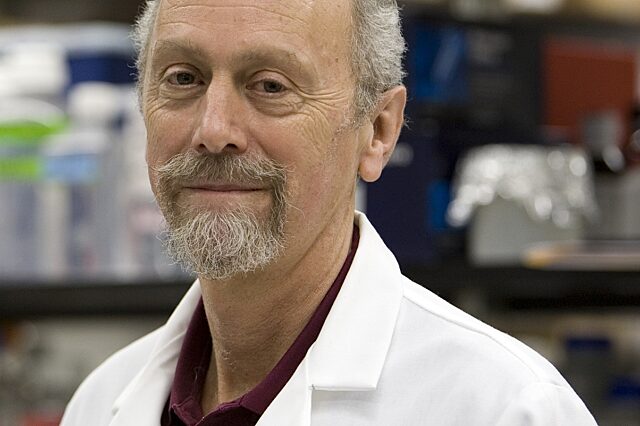UF Health researcher, collaborators share $1.2 million international award for vision treatment

Go to http://bit.ly/2klTAMx to see a video about the gene therapy developed at the University of Florida. Visit http://bit.ly/2qFfvUk for a UF Health video about how AAV gene therapy works.
University of Florida Health ophthalmology researcher William Hauswirth, Ph.D. and his collaborators are sharing in a $1.2 million international award for developing a sight-restoring treatment for people who have a genetic form of vision loss.
The 2018 Antonio Champalimaud Vision Award recognizes Hauswirth and his colleagues for developing the first successful gene therapy to cure an inherited human disease. The disease, Leber congenital amaurosis Type 2, or LCA 2, is caused by a genetic defect. The 1 million euro (approximately $1.2 million) award from the Portugal-based D. Anna de Sommer Champalimaud and Dr. Carlos Montez Champalimaud Foundation is shared with University of Pennsylvania and University College of London researchers.
The award lauds the six researchers’ efforts to design what the foundation called “the elegant solution” of providing functional replacement of the RPE65 gene in the eye.
An ophthalmology professor in the UF College of Medicine, Hauswirth spent decades developing and testing the gene therapy with University of Pennsylvania collaborators. The treatment, known commercially as Luxturna, was brought to market by a Philadelphia pharmaceutical company and approved by the U.S. Food and Drug Administration in December.
Hauswirth said he is honored to share the award with longtime collaborator Samuel G. Jacobson, M.D., Ph.D., a Penn ophthalmology professor. That partnership, as well as two decades of work with a Penn veterinary researcher, led to the development of gene therapies in animal models for a variety of genetic blindness, Hauswirth noted.
“This award will significantly aid our current quest with Penn, other universities in the United States and Israel and corporate partners to develop similarly effective gene therapies for more than a dozen other genetic forms of vision-robbing conditions in patients. Stay tuned!” he said.
Hauswirth said his share of the award — about $165,000 — will be used to advance research efforts to develop effective cures for blindness.
“Flexible research funds like this are rare and incredibly valuable in being able to jump quickly on any new results that may allow a different class of genetic blindness to also be attacked,” he said.
Hauswirth’s work on gene therapy for LCA2 started in the late 1990s. He provided a gene-delivery vehicle, known as an adeno-associated virus vector, to the Penn researchers. The treatment technique devised by Hauswirth uses a harmless virus to deliver a functional copy of a crucial, sight-saving gene to the retina. It was used to restore a dog’s sight in 2001 and was later found to be safe and effective in humans.
There are about 4,000 patients in the United States and Europe with LCA2, which affects specialized light and color-detecting tissue in the back of the eye. Treated patients had their vision improve by about 40,000-fold, Hauswirth and his Penn collaborator found during trials in humans. Almost all of the patients showed measurable vision improvements, he said.
The Vision Award recognizes the broad array of discoveries that are needed to bring a new treatment to patients. Those include the basic science of the RPE65 gene, developing the tools to deliver genetic materials into cells, and testing the therapy in animals and humans.
The winners are chosen by an international panel that includes Nobel Prize-winning scientists, distinguished clinician-scientists and prominent leaders in international development. The awards can be used to pursue more open-ended, creative research that otherwise might not get more conventional grant funding, the foundation said.
About the author
